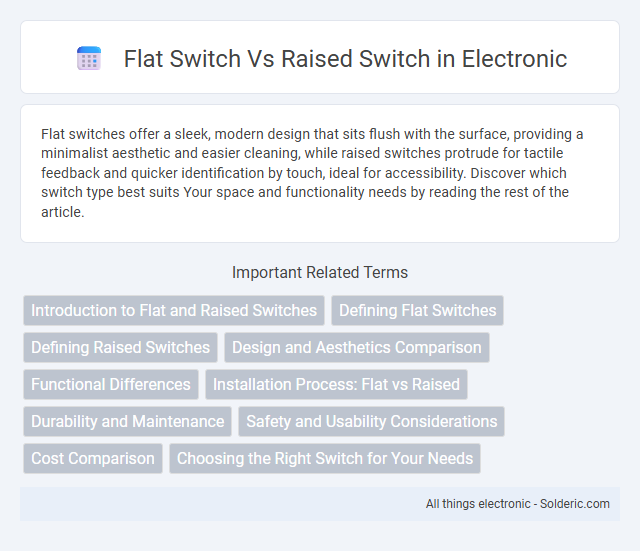Flat switches offer a sleek, modern design that sits flush with the surface, providing a minimalist aesthetic and easier cleaning, while raised switches protrude for tactile feedback and quicker identification by touch, ideal for accessibility. Discover which switch type best suits Your space and functionality needs by reading the rest of the article.
Comparison Table
| Feature | Flat Switch | Raised Switch |
|---|---|---|
| Design | Sleek, flush with surface | Elevated, protrudes above surface |
| Installation | Requires precise mounting | Simple, easier to install |
| Accessibility | Less tactile feedback | Enhanced tactile feedback |
| Maintenance | Harder to clean, dust prone | Easier to clean, less dust buildup |
| Application | Modern interiors, minimalistic style | Traditional setups, functional spaces |
| Durability | Less impact resistant | More robust and sturdy |
Introduction to Flat and Raised Switches
Flat switches feature a smooth, level surface that integrates seamlessly with walls, offering a minimalist design ideal for modern interiors, while raised switches protrude above the wall surface, providing tactile feedback and ease of use, especially for users with mobility challenges. Both types vary in materials and electrical ratings, catering to different aesthetic preferences and functional requirements. Choosing between flat and raised switches depends on factors such as installation environment, user accessibility, and design consistency.
Defining Flat Switches
Flat switches are designed with a smooth, level surface that sits flush against the mounting panel, providing a minimalist and modern aesthetic. These switches often utilize capacitive or touch-sensitive technology, enhancing ease of use and reducing mechanical wear. Their low-profile design makes them ideal for contemporary interiors where sleek and unobtrusive controls are desired.
Defining Raised Switches
Raised switches are tactile components designed with an elevated surface that extends above the switch plate, providing a distinct physical cue for improved accessibility and ease of use. These switches are commonly used in environments where users require enhanced feedback or visibility, such as in commercial buildings, healthcare facilities, and for individuals with limited dexterity or visual impairments. The raised design facilitates quick identification by touch and reduces the risk of accidental activation, making them essential in safety-critical applications.
Design and Aesthetics Comparison
Flat switches offer a modern, sleek design that blends seamlessly with minimalist interiors, providing a clean and unobtrusive look. Raised switches feature a more traditional, tactile style with prominent edges, making them easier to locate by touch and adding a classic architectural element to your space. Your choice between flat and raised switches will significantly impact the overall aesthetic and user interaction within your environment.
Functional Differences
Flat switches offer a sleek design with a low profile, providing easy cleaning and minimal dust accumulation, while raised switches feature tactile feedback that enhances usability by allowing you to feel the switch position without looking. Raised switches often improve accessibility for individuals with limited dexterity due to their pronounced edges and physical separation from the panel surface. Your choice depends on whether you prioritize aesthetics and smooth surfaces or tactile functionality and ease of use.
Installation Process: Flat vs Raised
Flat switches typically offer a streamlined installation process due to their low-profile design, allowing for easier alignment and integration with wall surfaces. Raised switches require additional consideration for mounting depth and alignment, as their protruding structure necessitates careful placement to ensure secure attachment and aesthetic consistency. The choice between flat and raised switches influences installation time and complexity, impacting labor costs and finish quality in electrical projects.
Durability and Maintenance
Flat switches feature a sleek design with fewer crevices, making them easier to clean and less prone to dirt accumulation, which enhances their maintenance efficiency. Raised switches, while often more durable due to their robust construction, may experience more wear over time as the protruding components are exposed to physical impact. Your choice should consider the balance between the ease of upkeep with flat switches and the potentially greater longevity offered by raised switches.
Safety and Usability Considerations
Flat switches offer a sleek design that reduces dust and dirt accumulation, enhancing safety by minimizing fire hazards and electrical faults. Raised switches provide tactile feedback, improving usability for visually impaired users and reducing accidental activation. Both types require proper installation to ensure optimal safety and functionality in various environments.
Cost Comparison
Flat switches generally cost less than raised switches due to simpler design and lower material usage, making them a budget-friendly option for your electrical needs. Raised switches, with their ergonomic design and often enhanced durability, tend to have a higher price point reflecting the added manufacturing complexity. Choosing between the two depends on your preference for cost savings versus increased accessibility and tactile feedback.
Choosing the Right Switch for Your Needs
Selecting the right switch depends on both functionality and aesthetic preferences; flat switches offer a sleek, minimalist design ideal for modern interiors, while raised switches provide tactile feedback and ease of use, especially for users with limited dexterity. Consider the environment and user requirements: flat switches are easier to clean, making them suitable for kitchens and bathrooms, whereas raised switches are typically preferred in high-traffic areas for their durability and accessibility. Evaluating factors like installation space, user comfort, and design integration ensures the switch complements both your lifestyle and the room's decor.
Flat switch vs Raised switch Infographic

 solderic.com
solderic.com